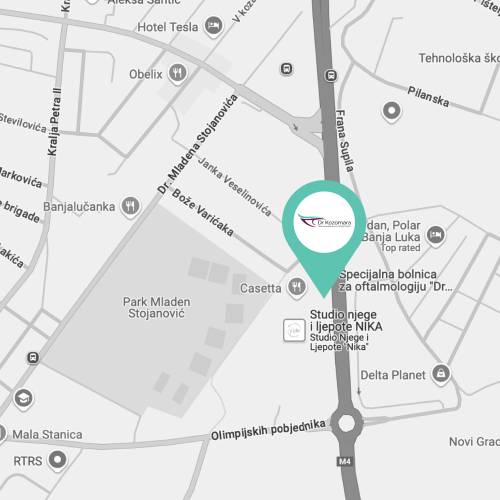
SHORTSIGHTEDNESS OR MYOPIA (CAUSES, SYMPTOMS, TYPES AND TREATMENT)
If you’ve noticed that you can’t see objects that are far away, such as road signs until you’re a few meters away from them, but on the other hand, you can read a book without any problems, there’s every chance that it’s myopia (diopter minus) i.e. myopia.
Myopia is a condition that occurs in a large number of people and is one of the most common “problems” with the eyes. Fortunately, myopia can be easily corrected by wearing glasses, contact lenses, or surgery.
What causes myopia?
When it comes to myopia or minus diopters, you should look for the culprit in the structure of your eye. When the eyeball is too long or the cornea – the protective part of your eye – is too rounded, the light coming into the eye from the front of the retina simply doesn’t focus properly. In simpler terms, you can’t see well and need a distance diopter.
The image you see is focused from the front of the retina, the part of the eye that is sensitive to light, instead of directly onto the retina, and this is what causes blurred vision.
How much time you spend indoors and how much time you spend outdoors can also affect your vision and eye health. If you spend a disproportionate amount of time reading, writing, or at the computer, it can be a trigger for short-sightedness or myopia. However, in most cases, it is a matter of genetics, and if your parents are short-sighted, it is very likely that you will also be short-sighted.
Although the contrast between outdoor and indoor light can increase the degree of myopia during the developmental stage, it is important to provide your eyes with a good balance between sunlight and artificial light. In this way, you will act to reduce the load on your eyes, and thus the degree of myopia will also decrease.
Believe it or not, short-sightedness or myopia has to do with demographic categories, so it has been proven that it is more common in people of Asian descent. When it comes to the elderly population, myopia is often an early indicator of cataracts, and although it most often occurs during puberty, it can occur at any age. You can schedule your appointment here if you need cataract or cataract surgery.
Myopia – types
High myopia, is defined as a somewhat more serious condition than ordinary myopia. In the case of high myopia, the eyeball grows more than it should and becomes very long at the front and back. In addition to causing us to need distance diopters, this form of nearsightedness can increase the risk of other conditions such as cataracts, glaucoma, or a detached retina.
Degenerative myopia, also called pathological or malignant myopia, is very rare and usually inherited from parents. In the case of this type of nearsightedness, the eyeballs become longer very quickly, and thus severe myopia occurs. Degenerative myopia most often appears in the teenage or adolescent days. Degenerative myopia often gets worse as we get older. This form of myopia can increase the risk of some other conditions such as a detached retina, abnormal growth of blood vessels in the eye, and glaucoma. In case you need glaucoma surgery – you can schedule your appointment here.
Minus diopter/myopia – symptoms
When it comes to the symptoms that will help you recognize whether it is myopia or not, things are very simple. Symptoms of myopia are as follows:
- Blurred vision when looking at objects that are far away.
- The need to squint or partially close your eyes to see better.
- Headache caused by eye strain.
- Difficulty seeing while driving, especially at night.
- As we have already mentioned several times, myopia is usually detected in childhood, between the early school days and the teenage years, and that is why it is very important to pay attention to whether your child shows any of the symptoms.
- Šlkiljenje,
- The need to sit near the television, monitor, or school blackboard.
- You are not aware of distant objects.
- Squinting
- The child often rubs his eyes..
When should I see a doctor if I suspect myopia?
If the problem with recognizing distant objects is causing you difficulty in carrying out your daily tasks or if the quality of your vision is affecting your quality of life, then it is time to see an ophthalmologist who will determine the degree of myopia and advise you on the best option for vision correction in your case. You can make an appointment for a general ophthalmological examination at this link.
Given that vision problems are not always easily noticeable, there are certain recommendations for when and how often the eyes should be checked.
If you are an adult who is at high risk of eye diseases such as glaucoma, then you should go for regular eye checks that include dilation of the pupils every two years, even if you do not notice any symptoms even when you turn 40. If you do not belong to the risk group, you do not feel any symptoms, then you should have your eyes checked according to the following schedule:
- Every five to ten years between the ages of 20 and 30
- Every two to four years between the ages of 40 and 45
- Every one to three years between the ages of 55 and 64
- Every year or every other year after turning 65
- If you wear glasses, or contact lenses or have certain problems, then you should go for check-ups regularly, as recommended by your ophthalmologist.
You can see the differences between myopia and farsightedness in the video below:
Minus dioptre correction
A diagnosis of myopia or nearsightedness is made after a basic eye examination that includes a refraction assessment as well as a physical examination of the eye. A refraction assessment determines whether you have a vision problem such as nearsightedness, farsightedness, astigmatism, or presbyopia.
After establishing the diagnosis, the doctor will recommend several types of minus dioptre correction that involve wearing corrective lenses in the form of:
Eyeglasses are the simplest way to sharpen the vision that myopia has worsened, and currently, there are various types of glasses such as bifocal, trifocal, and progressive multifocal glasses.
Contact lenses are worn directly on the eye and are available in a variety of varieties and materials, including soft and hard, gas permeable in combination with spherical, toric, and multifocal designs. Ask your eye doctor about the pros and cons of certain contact lenses and what might be best for you when it comes to minus diopters.
Laser eye surgery has recently been a very popular form of diopter correction because it is a permanent solution to the problem. During this operation, the surgeon uses a laser or another tool to create a thin flap at the very top of the surface layer of the cornea. After that, the cornea is shaped using a second laser, and the flap is returned to its place. In the case of high myopia, it has been found that special lenses or atropine-based eye drops can be effective in slowing the progression, and in some cases the ophthalmologist will suggest surgery to replace cataracts or clear lenses. If you are interested in laser dioptre removal surgery, you can schedule your appointment here.
Myopia – treatment, and treatments to stop the progression of myopia
Research has been going on for years that should find a more effective approach to treat myopia and stop the worsening of myopia that comes with time. Therapies that have so far proven to be the most effective for the treatment of myopia are:
Topical drugs, atropine drops, are often used to dilate the pupils and are mainly an integral part of the eye examination before and after surgery. Atropine drops can also help slow the progression of myopia.
More time spent outside, especially during the adolescent years, can reduce the risk of nearsightedness, and scientists believe that exposure to ultraviolet rays can affect the molecular structure of the eye and thus help the eye maintain its normal shape.
Bifocal contact lenses are a newer form of myopia correction that has been shown to slow progression in children between the ages of 8 and 12.
Orthokeratology is a procedure in which hard, gas-permeable contact lenses are worn for several hours a day until the eye regains its curved shape. After this happens, lenses are worn less often to maintain the shape of the eye. If you completely stop this treatment for nearsightedness, the eye may return to its original shape. There is evidence that these lenses slow the elongation of the myopic eyeball, which works to slow myopia.
If your doctor confirms that it is myopia, it is very important to follow some tips that will certainly help you slow down the progression naturally.
- You go for regular check-ups..
- Control chronic diseases, if you have them.
- Protect your eyes from the sun.
- Prevent eye injuries.
- Make your diet rich in nutrients.
- Leave the cigarettes.
- Use the right corrective lenses.
- Always use good lighting.
Contact your ophthalmologist if you experience a sudden loss of vision with or without pain, sudden blurred vision, double vision, flashes before the eyes, or black dots.
We hope that with this text we have managed to solve all the doubts you had about the term short-sightedness or myopia. We recommend you read below: Blepharoplasty – Lower and/or Upper Eyelid Tightening (DO YOU NEED IT?)
Take our quick test to find out if laser eye surgery is your path to glasses-free vision
Not all laser eye surgery options are the same. Find out which one is right for you by taking our quick 2-minute self-test
Our most popular procedures
What our patients say...

★ ★ ★ ★ ★
“All praise, expertise and kindness of the entire staff headed by Kozomara
"

★ ★ ★ ★ ★
“I turn to Kozomar ophthalmology with great pleasure, even though I came from Slovenia for their services. I am extremely grateful for their professional treatment during diopter removal and blepharoplasty. Every time I am impressed by their dedicated and precise work. I would especially like to emphasize the respectable attitude of the entire staff”

★ ★ ★ ★ ★
“All the best! Very satisfied with everything, from the appointment, examination, operation and control. Thank you to the doctor and the whole team for their expertise and kindness!!!”

★ ★ ★ ★ ★
“It is with great pleasure that I thank the entire staff and dr. Kosamora. I am very satisfied with the service, I came yesterday with very poor eyesight. They restored my vision to 100% painlessly, quickly and professionally. I recommend this clinic to everyone and THANK YOU very much. Sincerely, Adnan Jusić.”

★ ★ ★ ★ ★
“Congratulations, I've done several procedures so far, from aesthetics to vision correction. I'm over the moon! Kudos!”

★ ★ ★ ★ ★
“Very friendly staff, medical specialists and technology of the highest quality”

★ ★ ★ ★ ★“I found out about the clinic from a friend. The professionalism during the examination and the kindness of the entire staff, after two or three days they create an almost friendly relationship with the patients.”

★ ★ ★ ★ ★“Laser dioptre removal done in 3/23. Service at the level, wonderful and very kind staff. Everything was as it was said at the examinations. Clear vision from the first day, thank you from the bottom of my heart! ????”

★ ★ ★ ★ ★
“Excellent team, kindness and professionalism! All recommendations!”

★ ★ ★ ★ ★
“Very friendly and competent team!
Dr. Kozomara, himself is a top professional! I felt very well looked after. Was fully explained. I've been watching in HD quality for a few days now
Thank you very much!!!”
We have replaced the images of the actual patients who provided these testimonials to protect their privacy

